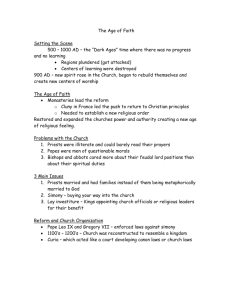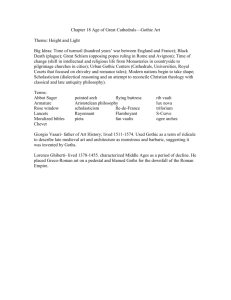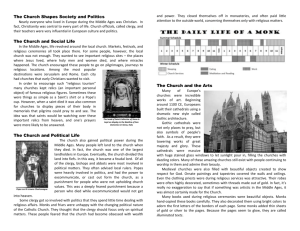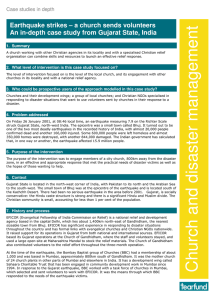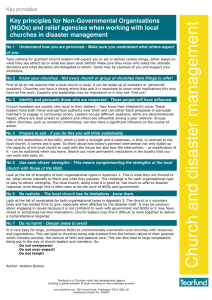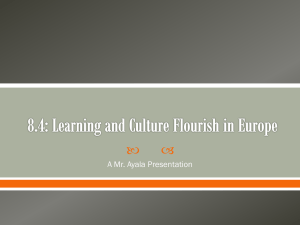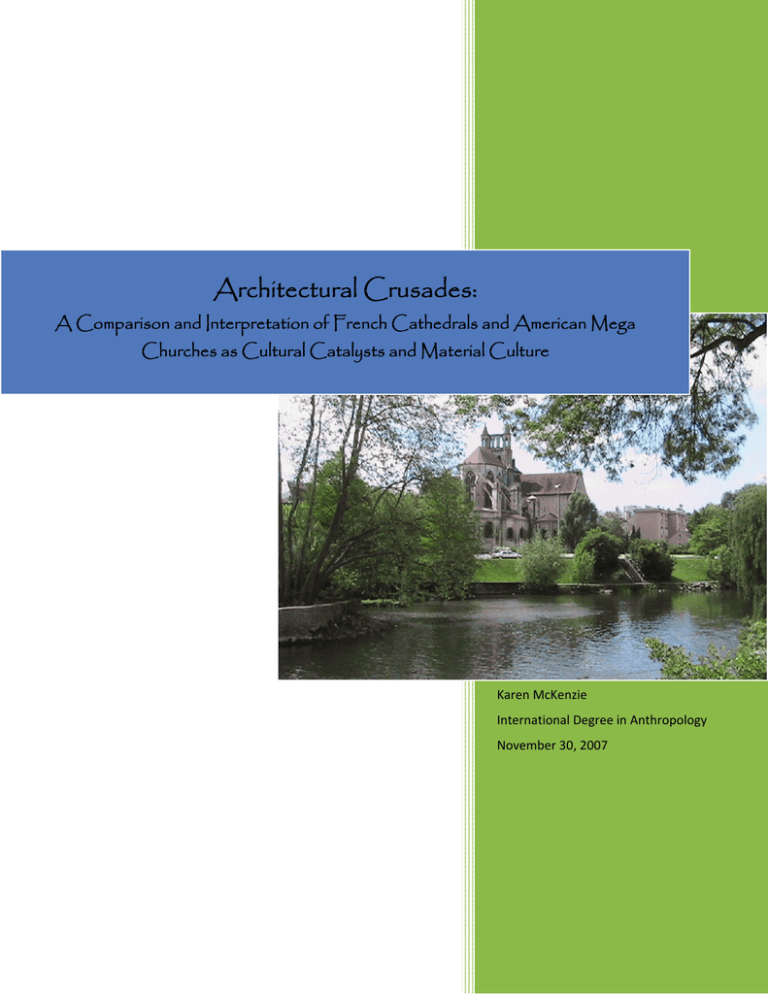
Architectural Crusades:
A Comparison and Interpretation of French Cathedrals and American Mega
Churches as Cultural Catalysts and Material Culture
Karen McKenzie International Degree in Anthropology November 30, 2007 Architectural Crusades:
A Comparison and Interpretation of French Cathedrals and
American Mega Churches as Cultural Catalysts and Material
Culture
by
Karen E. McKenzie
A THESIS
submitted to
Oregon State University
in partial fulfillment of the requirements for
the degree of
Bachelor of Arts in International Studies in Anthropology
Presented on November 30, 2007
2
AN ABSTRACT OF THE THESIS OF
Karen E. McKenzie for the degree of Bachelor of Arts in International Studies in
Anthropology presented on November 30, 2007. Title: Architectural Crusades:
A Comparison and Interpretation of French Cathedrals and American Mega
Churches as Cultural Catalysts and Material Culture.
The Gothic cathedrals of France arose in a particular social and political
environment, and the material culture, the structures themselves and their
contents, bear witness to those realities even today. In addition, the cathedrals
themselves were catalysts for cultural change. They encouraged urban growth
in a country that had previously been mostly rural, as craftsmen and parishioners
moved closer to the construction sites to enable themselves to take part in the
architectural and social evolution that was occurring as a result of the
unprecedented building projects. The cathedral towns become county seats, and
as such, the center for social and cultural activities. The cathedrals themselves
were symbols of the partnership of Church and State, and the strength that
partnership had garnered. The cathedrals changed the face of French society
forever.
The American mega churches today could be interpreted as a similar
phenomenon in some regards. They have served as a catalyst for cultural
changes, creating strong communities. Perhaps they represent a comparable
partnership between Church and State, even if this is not the most politically
correct interpretation at this point in history. The mega churches have cultivated
3
their own cultures, sometimes seeming like small cities with all that they have to
offer – coffee shops, bookstores, childcare, social programs and worship – all in
one large, convenient location.
The research represented in this paper has sought to examine the
differences and similarities between the medieval churches and the modern day
mega churches, and to make a logical and insightful comparison of the two
phenomena and then to develop an appropriate interpretation of that
comparison.
Although many fairly evident differences exist between the two, the
research revealed many similarities between the Gothic cathedrals of France and
the American mega churches, both in their construction and in their cultural
impacts. The resulting analysis revealed much, not only about French culture
and history, but about the American culture today as well.
Abstract approved: __________________________________________
Dr. David Brauner
4
© by Karen E. McKenzie
November 30, 2007
All Rights Reserved
5
Bachelor of Arts in International Studies in Anthropology
Thesis of Karen E. McKenzie
Presented on November 30, 2007
Approved:
Dr. David Brauner,
Dr. David McMurray
Dr. Joseph G. Hoff, Academic Coordinator, International Degree Program
I understand that my thesis will become part of the collection of Oregon State
University. My signature below authorizes release of my thesis to any reader
upon request. I also affirm that the work represented in this thesis is my own
work.
Karen E. McKenzie, Author
6
Acknowledgements
Thanks to Bruce, Kyle, my mother, and Dr. Brauner. Thanks to each one of you
for your immeasurable contribution to the fabric of my life, and to this paper and
the wonderful adventure it represents.
7
Table of Contents
Abstract
Page 2
Signatures
Page 5
Acknowledgements
Page 6
Table of Contents
Page 7
Introduction
Page 8
Methods
Page 11
Laying the Foundation: France in the Middle Ages
Page 12
Medieval Cathedrals and Symbolism
Page 20
Elements of Gothic Architecture
Page 22
An Enduring Style
Page 27
A Look at American Mega Churches
Page 28
Comparing Modern and Medieval Churches
Page 36
Conclusions
Page 39
References Cited
Page 40
8
Introduction
Gothic architecture, the major architectural movement in Europe
during the Middle Ages, was the product of, and the catalyst for, a period of
intensive social and economic transition. The joint power of Church and State
were expanding rapidly in Europe, and technology and culture were changing in
response to that expansion. This complex and unique architectural form
represented major technological developments which ultimately enabled the
construction of much larger and more impressive structures than had previously
been seen in Europe (Bumpus 1927:2).
The Gothic cathedrals of France, the best example of Gothic architecture,
have been a source of inspiration and awe to those who have entered their doors
since their construction during the Middle Ages. Their incredible immensity,
combined with the elaborate and extraordinary craftsmanship that resulted in a
beautiful material culture, even today presents thousands of visitors each year
with an otherworldly experience, surely much as they probably did during the
period in which they were developed. Those fortunate enough to have the
opportunity to visit such places tend to respond with amazement and wonder,
regardless of their spiritual or religious leanings. But these buildings are more
than the sum of what can still be seen today. They are the articulation of a
culture and a place in time that presents us with the opportunity to glimpse a
past way of life, and a catalytic point in time that literally changed the world.
9
One only has to know how to translate the material remains into an accurate
interpretation of the intents, beliefs and strivings of their planners and creators.
This paper will seek to inform the reader regarding the social, political and
religious origins of the cathedrals in France. Once the historical foundation is
laid, the physical structures of the cathedrals themselves will be examined.
Common structural and design elements will be highlighted, along with an
interpretation of their practical and symbolic purposes within the structures.
It is also the intent of this paper to examine the human experience of
cathedrals today in and of itself and then to compare it to the similar experience
of those visiting the modern mega churches in the United States, and to answer
some of the following questions related to the origins of the structures and their
eventual effects on culture.
What were the intentions of the builders of the Gothic cathedrals of
medieval France? What was the socio-political scenario in which they arose?
What was the relationship between church and state at the time? How did that
relationship contribute to the development of the architectural phenomenon?
Finally, how did the material culture express the beliefs and ideas of the people
of the time?
Next, the definition of “mega church” will be considered. This relatively
new phenomenon in the United States displays very specific characteristics of its
own. In comparison to the French cathedrals, what were the intentions of the
builders of the American mega churches? What was the social and political
10
scenario in which those particular churches have developed? What was the
relationship between church and state in the United States during the 20th
century? Did that relationship contribute to the choices made in the
development of mega church architectural phenomenon in America? How does
the material culture today express the beliefs and ideas of the churchgoers and
builders of our time?
Finally, what conclusions, if any, can be drawn from any similarities and
differences between the medieval Gothic churches of France and the modern day
American mega churches? Despite their geographical distance, is it possible that
there exists an evident universality of intent on the part of those in power in the
construction of the subject structures? Is there a similarity in the fashion in
which symbols and material culture have been and are still used to express
beliefs and ideas? Is there similarity in the emotional response felt by visitors to
the two distinct types of structures? Answers to all these questions have been
sought in the research process.
Obviously, the Catholic churches in medieval France are far different from
modern American Protestant churches. However, it is the similarities that are
perhaps the most interesting in the comparison. The comparison itself has
nothing to do with whether the church in question is either Catholic or
Protestant, but rather the focus of this study is the significance of the role played
in the culture of each type of church and comparing cultural phenomenon to
cultural phenomenon.
11
Methods
Preliminary research began prior to the writer’s arrival in France and
consisted of literature review focused on determining the viability of the
proposed subject matter and the thesis structure. Once a foundation for the
research was established, on-site research in France was undertaken. The incountry research took place over a period of ten months, and it consisted of site
visits to the churches, the collecting of French written documentation regarding
each subject structure, and the photographing of various pertinent aspects of
each building and its contents.
Stateside research continued with additional literature review and visits to
mega church structures. Here, it must be noted that some of the information
related to the American church is drawn from personal experience and
knowledge of the author as a previous member of an American mega church.
So, there is the element of an inside informer that is part of the process as well.
It must also be noted that finding good anthropological sources of information
relating to mega churches was a difficult task, due to the fact that they are a
relatively new phenomenon, having only really appeared in the past three to four
decades.
Finally, the data was assembled in logical fashion and comparisons were
made relating to structural similarities, political and social climate of the
respective eras in which the structures arose, and the other research questions
12
posed, along with similarities in the writer’s experience as it related to the
buildings.
Laying the Foundation: France in the Middle Ages
An understanding of the origin of the French cathedrals demands some
knowledge of French history preceding their construction. The early Middle Ages
in France were an extremely turbulent time, with many invasions and revolutions
as nobility struggled to assert and maintain power and territory, and peasants
resisted. Feudalism cultivated a society of warfare, an issue the Church
eventually sought to rectify (Evans 1969: 5). However, in spite of all the
divisions and disruption, France maintained a sense of country. In addition, a
tremendous amount of intellectual, political, social and artistic growth occurred
during the Middle Ages, heavily influenced by the preceding Roman culture
(Evans 1969:1). The monarchy and the church developed a partnership that
was based on the idea that the king’s power was given to him by God (Evans
1969:11). The Crusades occurred in the second half of the eleventh century,
and consequently, pilgrimages became a part of life which eventually focused on
the cathedrals (Evans 1969:37). The crypts of the saints, which were an
essential element in the cathedrals, gave the pilgrims a reason to travel long
distances to the churches. The pilgrims made the voyages, often seeking a
miraculous cure for terrible illnesses from the relics of the saints who rested in
the crypts (Hollister 2002:308).
13
The Crusades of France had a strong influence on politics and religion in
the country, providing a focus for chivalry for the nobility (Duby 1991:113).
Then, as the Crusades began to draw to a close, a new kind of crusade began to
bring together the countrymen and women of France. The task of building the
monumental cathedrals, which would serve as the crowning glory and
designating characteristic of capital cities, united the French people in a way of
life that changed France forever (Evans 1969:66). With its network of parishes
and local communities of believers, they brought to fruition a new, more complex
social organization. They became the centers for all major social activities. It
was within their walls that christenings, masses, weddings and funerals took
place. The cathedrals brought together people of all walks of life in one place
and one endeavor, creating a new deep-seated and much-needed sense of
community (Sot 1997:139). They spurred the development of strong urban
centers in a country that had previously been largely rural. The construction of
the cathedrals provided an almost limitless opportunity for craftsmen to refine
and practice their arts, resulting in a rich material culture that still bears witness
to some of the realities and thought-processes of the day (Sot 1997:131). In
addition, the great cathedrals served to solidify the developing partnership
between Church and State, while at the same time strengthening the position of
the Church in medieval French society (Sot 1997:139). It must be noted here,
however, that there was some scattered rural resistance to the new type of
construction and the demands of the projects, which is reflected in the
14
persistence of Romanesque architecture in some areas of the countryside (Sot
1997:135).
Interestingly, some of the churches that still stand today actually
represent a blending of Romanesque with Gothic. Instead of building entirely
new structures, the existing ones were enhanced by the addition of new Gothic
style architectural elements. An outstanding example of this is SainteRadegonde in Poitiers, which was dedicated in 1099. The exterior is obviously
Romanesque in origin, while the interior exhibits traits of Gothic architecture
such as the high vaulted ceilings, large windows and elaborate stained glass.
The Gothic elements in the church were added during the 13th century (Favreau
1999:33). Another excellent example of the blending of the two styles of
architecture is at the Abbey of Saint Jean de Montierneuf, originally built around
1069, and updated with Gothic elements at the end of the 13th or beginning of
the 14th century ((Favreau R. 1996:3).
Pacey referred to the period of cathedral construction as the “Cathedral
Crusade”. Following closely on the heels of the actual Crusades, the time
reflected the spirit of adventure and the idealism inherent to the quest for souls.
Once the building of the first cathedral began, the new ideas almost instantly
took root, and similar building projects rapidly sprang up across France (Sot
1997:133). Despite the uniqueness of each structure, reflecting the individual
philosophy and the creativity of each respective planner/builder, the buildings all
15
shared common characteristics, including flying buttresses, lightness and
verticality of structure, and brilliantly colored windows (Sot 1997:134).
Abbot Suger began construction of the first cathedral in St. Denis, France
in the late 1130’s in response to a need for a new way to unite the people and
move forward. The king of France was absent from the country at the time, and
Suger, an advisor and personal friend of Kings Louis VI and VII, was the acting
ruler of France (Pacey 1992:17).
Abbot Suger developed the Gothic style of architecture to reflect his own
philosophies, and he utilized it in the construction of the abbey church of SaintDenis, about four miles from Paris (Photos 1 and 2). His spectacular new
building was consecrated in 1144. In planning the building, he very deliberately
set out to design and to construct a structure that would be a physical
representation of Heavenly Jerusalem, with a lofty construction and an
abundance of brilliant color and light. The building was also created to represent
the power of the Church and its relationship with the State, a visual reminder of
things both religious and political. In addition, the expansive and lofty structures
emphasized, for all to see, the immensity of the universe and the glory of God, in
contrast to the apparent smallness and insignificance of mankind (Branner).
16
Photo 1 - Saint Denis (Branner 2005)
Photo 2 - Saint Denis (Branner 2005)
17
In short, Suger planned every element of the architecture to be symbolic
of his own philosophical and political ideals, based on the thought that there
would be a second crusade in the near future. Suger’s unprecedented project
caught the imagination of the French people, and eventually cathedral building in
and of itself became the second crusade (Pacey 1992:18).
As a result of Suger’s influence, medieval religious architecture developed
into a veritable art form created to reflect the heavenward aspirations of those
who built and worshiped within the buildings. It developed during a pivotal time
when the social and economic landscape in all of Europe was changing rapidly.
Both the iconography and the architecture of the cathedrals give us a glimpse
into the worldview of the people of the period (Branner).
Funding for the building ventures came from occasional gifts from kings
as well as contributions from townspeople and merchants. The cathedrals in
France were always extremely expensive, and they required the financial and
professional contributions (through monetary gifts, taxes and time donations) of
many parishioners and craftsmen, in addition to the state funds that were
devoted to the cause. Consequently, the communities surrounding the building
projects grew rapidly and exponentially as the many workers and craftsmen
relocated to live close to their work. Since the buildings took at least decades to
construct, the growth of the area was always relatively permanent. In addition,
people moved closer to the cathedrals because of the shift to industrialization
that came about in response to the new technologies that developed to
18
accommodate the construction needs of the massive structures. They migrated
to the towns where they could earn a living and be close to their place of
worship. New population centers sprang up, and as people came, they
contributed to the building endeavor, both financially and through their labor. In
return, they received a sacred place of worship. The indulgences which were
granted in return for monetary gifts toward the building projects were another
source of funding. The greatest percentage of financial support, however, came
from the exhibition of of saints’ relics and the resulting contributions from even
the poorest people and pilgrims who traveled long distances to view them
(Pacey 1992:25).
The churches quickly became the center of the communities. The bells of
the cathedrals rang to mark public events such as the birth of a royal heir, the
death of a significant individual, battle victories, and to call university students to
study. The churches served as the central gathering place for not only religious
but also civic events, including town councils, assemblies of nobles and princes,
and victory celebrations (Hollister, 2002:307).
The cathedrals were the symbolic gateway to on High. One might say
that Church and State were married in the cathedrals of the Middle Ages. The
majestic stained-glass windows, along with the elaborate statuary, illustrate
treasured Bible stories, as well as providing images of the royalty of the day. In
addition, the other items which were deliberately placed within the church give
19
us insight into the minds of the builders, planners and worshippers. Many
statues and icons of both heaven and of politics fill the buildings (Branner).
Gothic architecture was thus developed and used widely in Western
Europe from the 11th through the 16th century. It was preceded by the
markedly less ethereal Romanesque style and characterized by the immense
stained-glass windows, rib vaulting, pointed arches and spires, and a developing
emphasis on verticality and the impression of height. Flying buttresses were
developed to support the skeletal walls and large expanses of glass.
The cathedrals of Europe represent a rich legacy of artistic and
architectural expertise, and they are noteworthy due to their contribution to the
developing world at that time and their long-lasting influence on architectural
design. The architects and the patrons worked together to bring their projects to
fruition. Some of the most notable architects of the time are: Robert de
Luzarches, who worked with the local bishop to produce the Cathedral of
Amiens; Peter Parler, who worked on the church in Prague; Pierre de Montreuil,
who was the creator of the great Notre Dame in Paris, the abbeys of St. Germain
des Pres, and St. Denis; and Villard de Honnecourt, who created an important
manual for the construction of the cathedrals, but of whom there is no known
record of actually having actually constructed a church (Branner).
The style became popular first in France and soon spread to the rest of
Europe. The Gothic cathedrals consisted of the same basic parts, but were fluid
in their sizes and shapes, and tailored to the needs of the congregation building
20
each one. Gothic architecture remained popular through the 16th century
(Branner).
In addition, the cathedrals represent a penchant for experimentation and
pushing the limits of structure and aesthetics, along with an unwillingness to
accept anything as being enough. Competitiveness between towns was also a
factor, with each town working to make their cathedral the biggest, most
beautiful and best. This drive echos the spirit of conquest that was exemplified in
the Crusades (Pacey 1992:23).
Medieval Cathedrals and Symbolism
Because of the meticulous and thoughtful fashion in which each one was
designed and constructed, the cathedrals of France can be read like a book.
They are repositories of symbolic represenations of the cleric, laymen and
communities of the time in which they were constructed (Sot 1997:138). Every
aspect of a cathedral is an expression of a concept, a theological order, sacred
space, and of the Christian community. It was seen as a representation of the
body of Christ (Sot 1997:135). Sot describes the cathedral as a window into
medieval thought, the articulation of the hierarchy between the material and
non-material worlds. It provides clues today that enable one to understand, to a
small degree, their vision of the habitation of God (Sot 1997:137). The twintowered western sides of the cathedrals were built as the gateways to God’s
residence on earth (Crewe, 1986: 13)(Photo 1). The richness of the aesthetics
of the cathedrals cannot be separated from the morals and theology they
21
represent (Sot
1997:137). The
cathedrals’ interior
spaces are places of
hierarchy, organization,
value, positivity,
sanctified and
sanctifying. All these
represented qualities
were created as a
contradiction to the
disorganization of the
external world, similar
to the contradiction
Photo 3 - Notre Dame, Paris
between the Christian order and the rest of the world (Sot 1997:138).
Pacey cites church texts relating to church building dedication as making it
clear that one intent in building such amazing structures was the creation of a
representation of the New Jerusalem seen by Saint John the Divine in a vision in
the book of Revelation in the Bible. In addition, the cathedrals were related to
the historic city of Jerusalem as well as Solomon’s Temple (Pacey 1992:44).
Pacey also writes of cathedrals as “an art form, expressing religious truths
through symbolism, and religious emotion through mass and space and soaring
22
height” (Pacey 1992:23). In addition, because of the relationship between
Church and State in their construction and use, the cathedrals themselves
signified the piety of the State and its love for God. Architecture was more than
a simple structure in the case of the cathedrals. It was an intellectual expression
of things Christian: hope, faith, trust in God and love for Christ (Bumpus,
1927:3).
Elements of Gothic Architecture
Gothic architecture was very different from its predecessor, Romanesque
style, and represents a major transition in the church and society, reflected in
architecture. The Gothic style is much more open, lofty and light than the older
architectural form. Romanesque often consisted of stone ceilings and extremely
thick supporting walls, making it impossible to use large windows or high
ceilings. This resulted in very large, dark buildings (Branner). Due to the fact
that the Church was the entity truly responsible for its development, the Gothic
style is best known and most visible in its use in the building of cathedrals and
churches of its time. Although the style came to be used in many types of
buildings throughout the centuries during which it was in vogue, it was the
Church that recruited some of the best minds and talents of the day in order to
create the revolutionary architectural form. At that time, education was the
purview of the church, and it was for that reason that many of the great minds
of the time were available to take on the task of developing a new way of
building (Branner).
23
Gothic architectural style features high skeletal stone structures which
provide framework for prolific and sizeable stained glass windows (Photo 4).
These windows allow well-lighted interiors and are integral to the form. Also
featured are pointed spires (see Photo 5), flying buttresses (see Photo 6), cluster
columns, ribbed vaults (see Photo 7), and ogive-shaped, pointed arches (see
Photo 8). Great sculptural detail is another characteristic of Gothic architecture
and can be seen in all the structures of the style as well as in statues both on the
interior and the exterior of the buildings (see Photo 9) (Hollister, 2002:305).
Photo 4 - Sainte Radegonde, Poitiers
24
Photo 5 - Notre Dame, Paris
Photo 6 - Montierneuf, Poitiers
25
Photo 7 - Saint Pierre, Poitiers
Photo 8 - Saint Pierre, Poitiers
26
Photo 9 - Saint Pierre, Poitiers
Cathedral floor plans were that of a Latin cross, with a sanctuary with aisles and
radiating chapels (Bumpus 1927:5).
Figure 1 (Branner 2005)
27
An Enduring Style
Although more than one of the great structures have collapsed during or
shortly after construction, or were later destroyed in war or weather, many still
stand today to give the interested observer insight into the culture which
contributed to their development. They themselves remain as windows into the
past, allowing the willing observer to witness a snapshot in time and to
experience some measure of the awe that the men and women of the day must
have felt upon entering the immense, impressive works of art (Branner).
In recent years, tremendous efforts have been made to salvage and
renovate what is left of the structures. Many cathedrals have been repaired and
now serve not only as places of worship, but they have also been given their
rightful places as valuable cultural and historical sites. They have become civic
treasures which tell the story of a brave new era of thought and creativity. So,
they are an important part of European culture even today, and as a result
thousands of tourists visit them each year.
The Gothic architectural style itself occupies a significant place in history
throughout the western world, and the churches and cathedrals which still stand
today bear witness to that fact. Their unprecedented beauty and complex
design and the fashion in which they engaged both those in power and the
common man make them an important part of the material culture of the
European continent and they will stand as monuments to human achievement
and ingenuity for centuries to come.
28
A Look at American Mega Churches
During the twentieth century, the Christian church in the United States
began to grow exponentially. The movement focused strongly on converting
individuals in large numbers, a virtual quest for souls, and recruitment events
were often referred to as “Crusades”, echoing the Crusades of the Middle Ages.
The first mega churches began to appear in the 1970’s (Axtman, 2003). As the
church as a whole grew throughout the 1980’s, 90’s and into the new
millennium, more and more mega churches began to appear in suburban areas.
This phenomenon presented an opportunity for the gathering of unprecedented
numbers of believers under one roof. Perhaps the new mega churches were
spawned by a feeling of impotence which was prevalent amongst Christians at
the time, and the hope that in banding together in large numbers they might
wield more power. Mega churches provide a way for a group of people to create
a symbolic presence in modern American society. They take up noticeable
religious and social space as well as being visible on the physical landscape.
Because of this, they draw people to themselves. Growth begets growth
(Thumma 2006).
A mega church is defined as a very large, Protestant congregation,
generally having 2,000 or more persons in attendance at weekly worship; a very
active seven day a week congregational community; a charismatic, authoritative
senior minister; a complex organizational structure; and multiple social and
29
outreach ministries. The largest mega churches in the United States today boast
memberships of approximately 35,000 members. Some researchers believe that
the appearance of the mega church following the 1970’s is a response to
cultural, political and social changes in the country (Megachurches 2006).
Thumma lists three types of mega churches: nontraditional, traditional
and a composite of the two. The nontraditional churches avoid the traditional
architecture and instead build buildings that reflect other typical buildings in the
social milieu, such as shopping malls and office buildings. The traditional
churches tend to use either Colonial or Neo-Gothic architecture in their
structures, and employ a multitude of traditional Christian symbols, such as
crosses, candles, doves, and stained-glass windows within the building itself.
The composite churches are a blend of the two types, with the exterior reflecting
traditional church building ideology, while the interior is more like a theater, with
comfortable seating, excellent sound systems and video capabilities (Thumma,
2006).
Examples of modern mega churches are the Crystal Cathedral in Garden
Grove, California (Photos 10 and 11); Lakewood Church in Houston, Texas
(Photos 12 and 13); and Willow Creek Community Church in South Barrington,
Illinois (Photos 14 and 15). Each of these represents a nontraditional approach
to both exterior and interior design, with modern style architecture and theaterlike worship spaces.
30
Photo 10 - Crystal Cathedral (Symonds 2005)
Photo 11 - Crystal Cathedral (Symonds 2005)
31
Photo 12 - Lakewood Church (Symonds 2005)
Photo 13 - Lakewood Church (Symonds 2005)
32
Photo 14 - Willow Creek Church (Symonds 2005)
Photo 15 - Willow Creek Church (Symonds 2005)
33
Each of these styles of church structure also reflects a desire on the part
of the church leadership and congregation to meet specific needs within society
today. The nontraditional building is built with the unchurched in mind, while the
traditional is for the those who want the conventional Christianity venue, only
bigger and better. The composite type of church reflects a respect for the
traditional forms, while embracing the contemporary ideas of worship (Thumma
2006).
Many of the modern mega churches, particularly the nontraditional ones,
have dispensed with the use of religious symbols in the structure and décor, or
at the very least greatly curtailed it (Symonds 2005). The goal of this exclusion
is an effort to make those who would feel uncomfortable in traditional décor to
feel welcome and relaxed. The commercial, casual, comfortable and entertaining
multimedia world is embraced (Buggeln, 2004). Along with a deliberate
absence of religious symbols in the structure, the mega church culture urges
informality of dress, no longer pushing the idea of “Sunday best” that has for so
long been a part of the church culture in America (Axtman, 2003). Even the
pastors themselves often wear business casual attire, having set aside the dress
suit that has long been the costume of church leadership. They dress very much
like those in the congregation rather than in a manner that sets them apart or
above the flock (Florian, 2004).
It is interesting to note, as an aside, that a contemporary composite
church, First Baptist Church of Orlando, actually states in their brochure that the
34
building is “built with the feeling of a cross in a modern configuration similar to a
cathedral but with a contemporary design” (Thumma, 2006).
Modern mega churches often reflect the personality of the senior pastor.
This man is generally the founder of the church, and the creator of the vision for
the congregation. As such, his ideas for the architecture of the structure are
often borne out in reality (Thumma 2006). Under the direction of Senior Paster
Joel Osteen, and according to his vision, Lakewood Church in Houston actually
acquired the Compaq Center in Houston where the Houston Rockets had once
played (Photos 12 and 13), and renovated the building complex for their
congregation (Symonds 2005).
Mega church members tend to give financially far in excess of the national
average, enabling the construction and renovation of structures using the very
best building materials, creating environments that are pleasant and inviting
(Buggeln, 2004).
Mega churches seem to have sprung from a generation that is used to
large institutions: hospitals, high schools, universities, even shopping malls,
provide places where many people congregate under one roof. They are a
response to a demand for a communal experience, and a product of religious
marketing, an entertainment-oriented outlook, and religious marketing that is
identical to the way that businesses do marketing. While 60 churches per week
with memberships under 100 are closing their doors, mega churches have
increased their number by 30% in the past four years. This phenomenon is
35
much the same as that experienced when Walmart or Costco moves into an area
previously occupied only by small businesses. There is a consumer shift from the
smaller businesses to the larger stores that conveniently offer more products in
one place (Axtman 2003).
Mega churches, due to the diversity of attendees, must meet varying
social needs. As a result, the mega church has developed into a place for onestop shopping. The church building actually functions like a spiritual shopping
mall where many different ministries can operate in to meet the needs of the
many different consumers. The church serves as a social center for its members
(Thumma 2006). Services such as low-cost bulk food, self-help groups, financial
counseling, bookstores, food courts, coffee shops, organized sports, summer
camps and even auto repair are offered by many of the organizations (Symonds
2005). Symonds writes of “Sunday schools that look like Disney World and
church cafes with the appeal of Starbucks” (Symonds, 2005). Disney World and
Starbucks are very succinct expressions of modern culture; perhaps it isn’t
surprising that a church venture that works mimicks those parts of American
culture that make people feel good. The mega church, in a phrase, is culturally
relevant. It acknowledges the culture in which Americans live, and focuses on
meeting the needs of the people (Florian, 2004).
Mega churches draw attendees of all ethnicities, many of them having
essentially equal numbers of Hispanic, white and African American members
(Axtman 2003).
36
Used to the anonomity of modern life, people seek out a place to worship
that affords them a similar level of anonymity (Thumma 2006). Anonymity is
also important to those people who have had negative experience in smaller
churches (Axtman 2003). In addition, the feel-good spirituality is an response a
culture that is essentially me-centered (Florian, 2004). People today are always
looking for ways to enhance their lives, and the mega church offers products
that do just that.
The mega church appeals to an entertainment-oriented society, often
having a rock concert feel to their services, and a heavy reliance on multimedia
(Axtman 2003). Mega churches focus on a message of hope, life, victory and
celebration, not the traditional message that some feel has created a victim
mentality and a sense of having been beaten down (Axtman 2003). The mega
church focuses on an image of polished professionalism in line with modern
culture in its multimedia presentations, drama, and music, functioning from the
belief that excellence pleases God (Florian, 2004).
Comparing Modern and Medieval Churches
In a fashion similar to the cathedrals, mega churches arose in the United
States quite rapidly following the appearance of the first ones. There was a
veritable explosion of mega churches during the 1980’s (Thumma, 2006).
Also similar to the way in which Gothic architecture was a departure from
the preceding Romanesque movement, many modern mega churches broke from
37
the traditional Georgian, Gothic and Colonial styles of building that had
previously been used for church buildings in the United States.
Like the churches in France, the modern buildings came at a great cost
related to the use of fine materials and the importance of aesthetics. Also like
the French churches, the construction occurred as a result of great sacrifice on
the part of many people, both rich and poor, incurring criticism for the opulent
buildings in a time when many people were destitute and suffering.
The mega churches today, like the cathedrals, often favor immense, highceilinged buildings with a lot of light, in spite of their nontraditional forms.
Unlike the cathedrals, the modern mega church buildings do not represent
a major architectural or technological accomplishment. Many other extremely
large buildings have been built in past years, and there is nothing particularly
remarkable about these, other than the size being built by a church. The
modern churches do represent some level of social change, but not the allencompassing change created by the building of the cathedrals. These buildings
might change the face of the community in which they are built, but they do not
engage the entire community in the same manner as the cathedrals. The
changes created by the modern churches are the gathering of larger
congregations and some restructuring within the church itself, such as home
Bible study groups to enable members to have some intimate social contact with
other believers apart from the huge assemblies, but there are no major changes
in social or cultural life that are generalized to the entire population of the
38
community in which the churches appear. However, the gathering of such a
large number of people in accord does give them the power of numbers, as was
borne out in the way in which the religious right, perhaps made cohesive and
given a sense of unity by the large churches, has swung the past two
Presidential elections, thus causing major political and social changes in the
United States. The church in America today boasts a membership including
many affluent individuals and notable political figures, including George W. Bush
and at least a dozen members of Congress. Unlike the cathedrals, the modern
mega churches were not state subsidized, but they have had an astounding
impact on American society and politics (Symonds 2005). The mega churches
are the organization responsible for the get-out-the vote rallies, stressing the
importance of politics to the religious, ultimately resulting in major political
changes in 2000 (Axtman, 2003).
Mega churches are usually located in suburban rather than urban areas
like the cathedrals (Thumma, 2006).
Unlike the medieval church, the church today is not dealing with an
illiterate population, thus alleviating the need for extensive symbolism in the
structure and contents of the building. Today’s believers can read in books what
they need to read to understand their faith. However, the use of stained glass
windows is still a favored construction choice in the traditional style structures,
providing some opportunity for the building to serve as witness to tenets of the
faith in some measure.
39
Conclusions
The built environment provides an archaeologist with a tremendous
amount of useable data, and the medieval cathedrals and today’s mega churches
are no exception. While there are many differences between the two, there are
also some apparent similarities. Each of them provides a window into the culture
of their time, illuminating facets of the societies in which they have been
constructed. Both the cathedrals and the mega churches are products of their
era, and at the same time, serve as catalysts for cultural, social and political
change. Similar intents and ideas have cultivated their development, and similar
cultural changes occurred as a result of their appearance on the social and
physical landscape. It is evident that these buildings have had and will continue
to have a significant role in culture.
40
References Cited
Axtman, K.
"The Rise of the American Megachurch." Christian Science Monitor 30
December 2003: 94-96.
Branner, R.
Gothic Architecture. 15 November 2005
<http://www.columbia.edu/~eer1/branner.html>.
Buggeln, G.
"Sacred Spaces." Christian Century 15 June 2004: 20-25.
Bumpus, T.F.
The Cathedrals of France. Tonbridge, England: Tonbridge Printers, Ltd.,
1927.
Clark, S. A.
Cathedral France. New York: Robert M. McBride & Company, 1931.
Crewe, S.
Visionary Spires. New York, NY: Rizzoli International Publications, Inc.,
1986.
Duby, Georges.
France in the Middle Ages 967-1460. Cambridge, MA: Basil Blackwell, Inc.,
1991.
Evans, J.
Life in Medieval France. London: Phaidon Press, Ltd., 1969.
Favreau, R.
Poitiers - Sainte-Jean-de-Montierneuf et son Quartier. Poitiers: Aubin
Imprimeur Liguge-Poitiers, 1996.
Favreau, R., J. Marcade, M. Mathieu.
"Histoire du Chapitre et de la Paroisse de Sainte-Radegonde."
Favreau, R.
Poitiers - Sainte-Radegonde. Poitiers: Ets Gehan, 1999.
Florian, A.
"My Neighbor, the Evangelical Megachurch." Liturgy 2004: 25-31.
History and Significance - St. Denis Abbey. 27 November 2005.
41
History of Art and Architecture: Gothic Art. 22 November 2005
http://beloit.edu/~arthist/historyofart/gothic/chatrescath.htm#artifact8.
Hollister, C.W., and J.M. Bennett.
Medieval Europe, A Short History. New York: McGraw Hill, 2002.
Kraus, H.
Gold was the Mortar. London: Routledge & Kegan Paul, 1979.
Megachurches. 2006. 18 October 2007
<http://hirr.hartsem.edu/megachurch/megachurches.html>.
O'Reilly, E.B.
How France Built Her Cathedrals. New York: Harper & Brothers Publishers,
1921.
Pacey, A.
The Maze of Ingenuity. Cambridge, MA: The MIT Press, 1992.
Sot, M.
Histoire Culturelle de La France: Le Moyen Age. Paris, France: Editions du
Seuil, 1997.
Symonds, W.C., B. Grow, and J. Cady.
"Earthly Empires." Business Week 23 May 2005: 78-88.
The Anatomy of Mega Churches. 10 October 2005. 26 October 2007
<http://www.slate.com/id/2127615/>.
Thiry, P., Bennett, R.M., and Kamphoefner, H.L.
Churches & Temples. New York, NY: Reinhold Publishing Corporation,
1953.
Thumma, S.
Exploring the Megachurch Phenomena: Their characteristics and cultural
context. 2006. 18 October 2007
<http://hirr.hartsem.edu/bookshelf/thumma_article2.html>.
42


